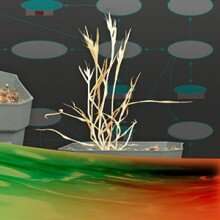Scientists studied the metabolic response of a temperate grass to water deficits to determine how to improve crop tolerance to drought. Credit: Nathan Johnson, PNNL Creative Services.
Drought has plagued agriculture for centuries. Scientists suspect the reason plants survive under drought may have something to do with the plant's genetic programming and metabolic activities. A recent study delved deeper into the metabolic underpinnings of plants to understand what happens when they undergo prolonged drought stress to the point of mortality.
Drought can cause plants to age, killing cells. Fewer cells mean less water is needed, and the remaining cells can use the nutrients. This process, called senescence, helps plant survival, but it can have devastating effects on crop productivity. As temperatures warm and rainfall decreases in parts of the world, scientists, farmers, and bioengineers need to understand the processes of crop mortality and survival under sustained drought. The information gained in this study may help predict drought acclimation and improve drought tolerance in bioenergy and food crops.
Scientists at EMSL, the Environmental Molecular Sciences Laboratory, Pacific Northwest National Laboratory, and Washington State University assessed the morphological, physiological, and metabolic responses of plants to sustained water deficit. They chose Brachypodium distachyon, a drought-tolerant grass grown in temperate climates, in part because the Joint Genome Institute developed a robust genome for the plant. Understanding the plant's genome allowed the team to track metabolic activities more readily. Using the Plant Sciences Laboratory at EMSL, the scientists compared changes in biomass, leaf water potential, and chlorophyll levels of plants as the plants received slowly decreasing amounts of water. This drought treatment resulted in a decrease of all measured growth characteristics and affected several physiological parameters, including chlorophyll content, phytol, and antioxidants. Metabolites meant to protect the plant from environmental damage increased, as expected, but their quantities continued to change, even when plants had visibly aged. This finding suggests leaves of plants subjected to sustained drought and experiencing full discoloration continued to support metabolic reactions not directly tied to cellular disintegration. The results of the study provide insights into the processes underlying persistent metabolic activity during sustained water deficit and can aid in identifying mechanisms of drought tolerance in plants.
More information: Amir H. Ahkami et al. Metabolic shifts associated with drought-induced senescence in Brachypodium, Plant Science (2019). DOI: 10.1016/j.plantsci.2019.110278
Provided by Environmental Molecular Sciences Laboratory























